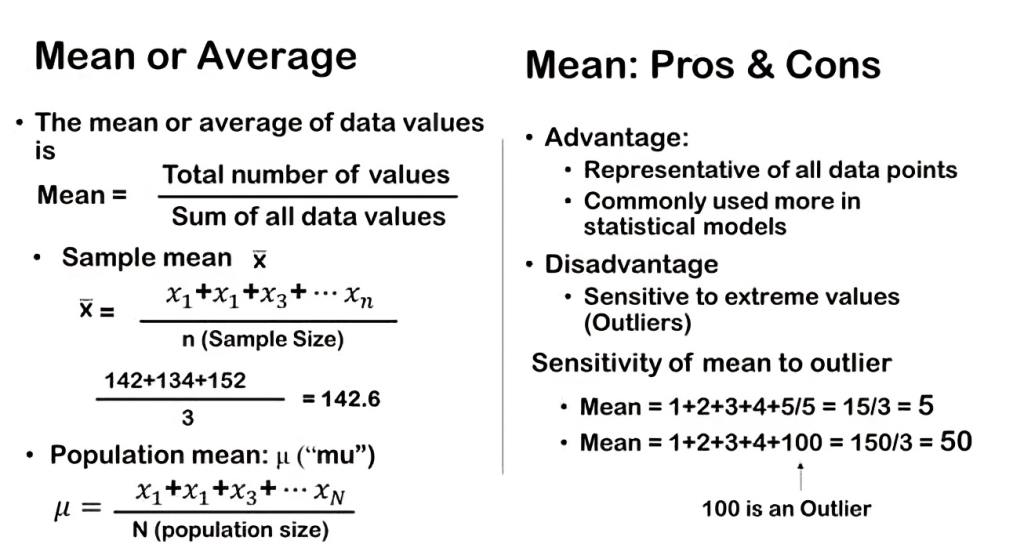Mean is the one of the most commonly used measures of central tendency. It’s a powerful tool for understanding the typical value in our data, showing us where the center of numerical variables lies. Let us take an example to calculate mean weight. The mean weight is simply the total weight of all individuals divided by the number of individuals. This gives us a sense of the “average” weight. Let’s take an example how we calculate the mean, or average, weight of three students—Ryan, Pushkar, and Dravid. To find the mean of the three students, we add up all the weights and divide by the sample size which is three, we get 142.6 pounds as shown in the above figure.
When we talk about the mean or average, we’re referring to the same concept. In statistics, it’s a fundamental measure of central tendency, helping us understand what the typical value is within a set of observations. By using simple arithmetic—summing up the observations and dividing by the number of observations—we can easily find the mean.
Notation
It’s important to discuss the notation when summarizing data. Generally, when dealing with dataset we deal with hundreds of data node, it can become quite cumbersome to manage if we keep track of individual responses. This is where notation becomes incredibly handy. Instead of tracking each parameter, we use concise notation to streamline our analysis. This method is not only efficient for our dataset but also essential when dealing with datasets containing millions of observations.
When we talk about the mean or other measures, we collect different observations for a variable, which we can call it X. Suppose we have three students—Ryan, Pushkar, and Dravid. Instead of repeatedly writing their names, we use subscripts to label each observation:
x_1: Observation for Ryan
x_2: Observation for Pushkar
x_3: Observation for Dravid
This concise notation allows us to easily reference specific data points. For instance, when we mention x_3, we know we’re talking about Dravid’s weight. Using this notation, we can quickly refer to any student’s data and their corresponding values. This makes our analysis much smoother. With this shorthand notation, we can easily handle massive datasets, making it possible to perform complex analyses without getting bogged down by individual details. This approach allows us to focus on the big picture and derive meaningful insights from our data.

Samples vs. Populations
In statistics, it’s crucial to distinguish between a sample mean and a population mean. Recall that a sample is a subset of a population. There is a complete article that discusses the nuance of sample and population which can be found here (link to article 3). Statisticians and data analysts often work with samples because they’re easier and cheaper to collect compared to an entire population. Conducting a census for a population is costly and time-consuming. Therefore, much of statistics involves taking a sample from a population and making inferences about the population based on that sample.
So, coming back to mean if data set of observations is a sample, then we call the mean x ̅ (pronounced as X bar). It’s just an X with a line over this is just by convention. If the data set is a population then we call the mean µ, this is a Greek letter mu. The important point is that in general when we talk about population parameters and versus sample statistics the population parameters are expressed in Greek letters typically and the sample statistics are represented in Latin or Roman letters.
Mean of a sample vs population
Understanding how to calculate means from samples versus populations is essential in statistics. Although the formula remains the same, the notation differs slightly, which clarifies whether we’re working with a subset or the entire dataset.
When calculating the mean of a sample, denoted as x ̅, you sum up all the observations (represented as x_i, where i ranges from 1 to n, and n is the sample size), and then divide by the sample size, n. This gives x ̅, which represents the average value of sample.
On the other hand, when dealing with populations, we use a different notation. The total number of observations in a population is denoted by capital N. For example, if we’re measuring the weight of all 160 billion people in India, N represents the total population size.
To find the population mean, denoted as mu (μ), we follow the same process: sum up all the observations across the entire population and divide by the population size, N. This results in the population mean, μ, which represents the average value of the entire population.
This distinction in notation—using small n for sample size and capital N for population size—helps to clearly differentiate between working with a subset of data versus the entire dataset.
Advantage & Disadvantage of mean
The mean, as a measure of central tendency, offers several advantages that make it widely used in statistical analysis. Primarily, it provides a single numerical summary that incorporates information from all data points within a dataset. This characteristic makes the mean highly representative of the entire dataset, offering a clear and concise average value.
Moreover, the mean holds universal applicability across various statistical and data analytic methods. Its widespread use from its simplicity and effectiveness in summarizing data, making it a fundamental tool in statistical inference and decision-making processes.
Drawbacks
However, despite its popularity, the mean has notable drawbacks, primarily its sensitivity to extreme values, also known as outliers. When an outlier—such as a significantly larger or smaller value compared to the rest of the dataset—is present, the mean can be heavily influenced. This sensitivity means that the mean may not accurately reflect the typical or central value of the dataset when extreme values are present.
To illustrate this sensitivity, consider an example where a dataset has values of 1, 2, 3, 4, and 5. Calculating the mean without the outlier gives a value of 3 (1+2+3+4+5 = 15; 15 / 5 = 3). However, when the outlier (100) is included, the mean shifts dramatically to 22 (1+2+3+4+100 = 110; 110 / 5 = 22). This stark change demonstrates how the mean can be skewed by just one extreme value, affecting its reliability as a measure of central tendency in such scenarios.
In conclusion, while the mean offers a straightforward and widely applicable measure of central tendency, its susceptibility to outliers underscores the importance of considering other measures—such as the median or mode—depending on the distribution and characteristics of the dataset. Understanding these nuances is crucial for making informed decisions and interpretations in statistical analysis.


